Biosensing System for Concentration Quantification of Magnetically Labeled E. coli in Water Samples
Abstract
1. Introduction
2. Design and Methods
2.1. Particle Tracking Principle
- Minimum and maximum size are introduced to specify the size range of particles whose trajectories are further analyzed (i.e., micromarker size range)
- Resolution—enables conversion of pixel units into real dimensions in micrometers; information about resolution must be provided while executing the additional scripts and calculations
- Time step Δt [in seconds]—is the time between two consecutive frames and is given by the camera frame rate (for 25 fps Δt = 0.04 s)
- minimum and maximum velocity—introduced to avoid the analysis of unwanted particles (e.g., foreign objects/dirt which experience different motion than the particles of interest)
2.2. Chip Design
2.2.1. Fabrication of Microconductors
2.2.2. Microfluidic Channel
2.2.3. Surface Modification
- Rinsed with acetone, isopropanol and deionized (DI) water to remove contaminants
- Dried for 30 min at 150 °C at a hot plate
- Oxygen Plasma etching (here hydroxylation of the SiO2 passivation layer took place)
- Dipped for 10 min in the branched, PEI 2 gL−1 solution that served as an adhesion promoter and rinsed with DI water
- Dipped in sodium alginate also for 10 min 2 gL−1, rinsed in DI water and dried carefully with Nitrogen
3. Experiments
3.1. Experimental Set-Up
3.2. Magnetic Markers
3.3. E. coli Sample Preparation
4. Results and Discussion
5. Conclusions
Author Contributions
Funding
Conflicts of Interest
References
- Jang, A.; Zou, Z.; Lee, K.K.; Ahn, C.H.; Bishop, P.L. State-of-the-art lab chip sensors for environmental water monitoring. Meas. Sci. Technol. 2011, 22. [Google Scholar] [CrossRef]
- Maas, M.B.; Perold, W.J.; Dicks, L.M.T. Biosensors for the Detection of Escherichia coli. Water SA 2017, 43. [Google Scholar] [CrossRef]
- Giouroudi, I.; Kokkinis, G. Recent Advances in Magnetic Microfluidic Sensors. Nanomaterials 2017, 7, 171. [Google Scholar] [CrossRef] [PubMed]
- Giouroudi, I.; Keplinger, F. Microfluidic Biosensing Systems using Magnetic Nanoparticles. Int. J. Mol. Sci. 2013, 14, 18535–18556. [Google Scholar] [CrossRef] [PubMed]
- Berthier, J.; Silberzan, P. Microfluidics for Biotechnology; Artech House: Norwood, MA, USA, 2010; ISBN 13-978-1-59693-443-6. [Google Scholar]
- Sackmann, E.K.; Fulton, A.L.; Beebe, D.J. The present and future role of microfluidics in biomedical research. Nature 2014, 507, 181–189. [Google Scholar] [CrossRef] [PubMed]
- Nguyen, N.-T.; Wereley, S.T. Fundamentals and Applications of Microfluidics; Artech House: Norwood, MA, USA, 2002. [Google Scholar]
- Beebe, D.J.; Mensing, G.A.; Walker, G.M. Physics and Applications of Microfluidics in Biology. Annu. Rev. Biomed. Eng. 2002, 4, 261–286. [Google Scholar] [CrossRef] [PubMed]
- Yager, P.; Edwards, T.; Fu, E.; Helton, K.; Nelson, K.; Tam, M.R.; Weigl, B.H. Microfluidic diagnostic technologies for global public health. Nature 2006, 442, 412–418. [Google Scholar] [CrossRef] [PubMed]
- Chin, C.D.; Laksanasopin, T.; Cheung, Y.K.; Steinmiller, D.; Linder, V.; Parsa, H.; Wang, J.; Moore, H.; Rouse, R.; Umviligihozo, G. Microfluidics-based diagnostics of infectious diseases in the developing world. Nat. Med. 2011, 17, 1015–1019. [Google Scholar] [CrossRef] [PubMed]
- Llandro, J.; Palfreyman, J.J.; Ionescu, A.; Barnes, C.H.W. Magnetic biosensor technologies for medical applications: a review. Med. Biol. Eng. Comput. 2010, 48, 977–998. [Google Scholar] [CrossRef] [PubMed]
- Wang, S.X.; Li, G. Advances in giant magnetoresistance biosensors with magnetic nanoparticle tags: Review and outlook. IEEE Trans. Magn. 2008, 44, 1687–1702. [Google Scholar] [CrossRef]
- Baselt, D.R.; Lee, G.U.; Natesan, M.; Metzger, S.W.; Sheehan, P.E.; Colton, R.J. A biosensor based on magnetoresistance technology. Biosens. Bioelectron. 1998, 13, 731–739. [Google Scholar] [CrossRef]
- Koh, I.; Josephson, L. Magnetic Nanoparticle Sensors. Sensor 2009, 9, 8130–8145. [Google Scholar] [CrossRef] [PubMed]
- Varadan, V.K.; Chen, L.; Xie, J. Nanomedicine: Design and Applications of Magnetic Nanomaterials, Nanosensors and Nanosystems; John Wiley & Sons: Hoboken, NJ, USA, 2008; ISBN 978-0-470-03351-7. [Google Scholar]
- Aivazoglou, E.; Metaxa, E.; Hristoforou, E. Microwave-assisted synthesis of iron oxide nanoparticles in biocompatible organic environment. AIP Adv. 2018, 8. [Google Scholar] [CrossRef]
- Kokkinis, G.; Plochberger, B.; Cardoso, S.; Keplinger, F.; Giouroudi, I. Microfluidic, dual purpose sensor for in-vitro detection of Enterobacteriaceae and biotinylated antibodies. Lab Chip 2016, 16, 1261–1271. [Google Scholar] [CrossRef] [PubMed]
- Jamalieh, M.; Kokkinis, G.; Haiden, C.; Berris, T.; Keplinger, F.; Giouroudi, I. Microfluidic Platform for Pathogen Load Monitoring. Microelectron. Eng. 2016, 158, 91–94. [Google Scholar] [CrossRef]
- Devkota, J.; Kokkinis, G.; Berris, T.; Jamalieh, M.; Cardoso, S.; Cardoso, F.A.; Srikanth, H.; Phan, M.; Giouroudi, I. A novel approach for detection and quantification of magnetic nanomarkers using a spin valve GMR-integrated microfluidic sensor. RSC Adv. 2015, 5, 51169–51175. [Google Scholar] [CrossRef]
- Kokkinis, G.; Jamalieh, M.; Cardoso, S.; Cardoso, F.A.; Keplinger, F.; Giouroudi, I. Magnetic based Biomolecule Detection using GMR Sensors. J. Appl. Phys. 2015, 117. [Google Scholar] [CrossRef]
- Kokkinis, G.; Cardoso, S.; Cardoso, F.A.; Giouroudi, I. Microfluidics for the Rapid Detection of Pathogens using Giant Magnetoresistance Sensors. IEEE Trans. Magn. 2014, 50. [Google Scholar] [CrossRef]
- Kokkinis, G.; Keplinger, F.; Giouroudi, I. On-Chip Microfluidic Biosensor using Superparamagnetic Microparticles. Biomicrofluidics 2013, 7, 7. [Google Scholar] [CrossRef] [PubMed]
- Gooneratne, C.; Yassine, O.; Giouroudi, I.; Kosel, J. Selective Manipulation of Superparamagnetic Beads by a Magnetic Microchip. IEEE Trans. Magn. 2013, 49, 49. [Google Scholar] [CrossRef]
- Gooneratne, C.; Giouroudi, I.; Kosel, J. A Planar Conducting Micro-Loop Structure for Transportation of Magnetic Beads: An Approach towards Rapid Sensing and Quantification of Biological Entities. Sens. Lett. 2012, 210, 769–773. [Google Scholar] [CrossRef]
- Li, F.; Giouroudi, I.; Kosel, J. A biodetection method using magnetic particles and microtraps. Virtual J. Biol. Phys. Res. 2012, 23, 6. [Google Scholar]
- Li, F.; Giouroudi, I.; Kosel, J. A biodetection method using magnetic particles and microtraps. J. Appl. Phys. 2012, 111. [Google Scholar] [CrossRef]
- Gooneratne, C.; Liang, C.; Giouroudi, I.; Kosel, J. An integrated micro-chip for rapid detection of magnetic particles. J. Appl. Phys. 2012, 111. [Google Scholar] [CrossRef]
- Crocker, J.C.; Grier, D.C. Methods of Digital Video Microscopy for Colloidal Studies. J. Colloid Interface Sci. 1996, 179, 298–310. [Google Scholar] [CrossRef]
- Haiden, C.; Thomas, W.; Martin, J.; Franz, K.; Michael, J.V. Sizing of Metallic Nanoparticles Confined to a Microfluidic Film Applying Dark-Field Particle Tracking. Langmuir 2014, 30, 9607–9615. [Google Scholar] [CrossRef] [PubMed]
- Haiden, C.; Thomas, W.; Martin, J.; Franz, K.; Michael, J.V. A Microfluidic Chip and Dark-Field Imaging System for Size Measurement of Metal Wear Particles in Oil. IEEE Sens. J. 2016, 16, 1182–1189. [Google Scholar] [CrossRef]
- Haiden, C.; Thomas, W.; Martin, J.; Franz, K.; Michael, J.V. Concurrent Particle Diffusion and Sedimentation Measurements Using Two-Dimensional Tracking in a Vertical Sample Arrangement. Appl. Phys. Lett. 2016, 108. [Google Scholar] [CrossRef]
- Dangl, A. Biosensing Based on Magnetically Induced Motion of Magnetic Microparticles. Ph.D. Thesis, Technische Universität Wien, Vienna, Austria, 2013. [Google Scholar]
- Zhang, X.; DaShan, B.; Valerie, H.; Hongmei, H. A Brief Review of Recent Developments in the Designs That Prevent Bio-Fouling on Silicon and Silicon-Based Materials. Chem. Cent. J. 2017, 11. [Google Scholar] [CrossRef] [PubMed]
- Israelachvili, J.N. Intermolecular and Surface Forces; Academic Press: Cambridge, MA, USA, 2011; p. 402. [Google Scholar]
- García Núñez, C.; Sachsenhauser, M.; Blashcke, B.; García Marín, A.; Garrido, J.A.; Pau, J.L. Effects of Hydroxylation and Silanization on the Surface Properties of ZnO Nanowires. ACS Appl. Mater. Interfaces 2015, 7, 5331–5337. [Google Scholar] [CrossRef] [PubMed]
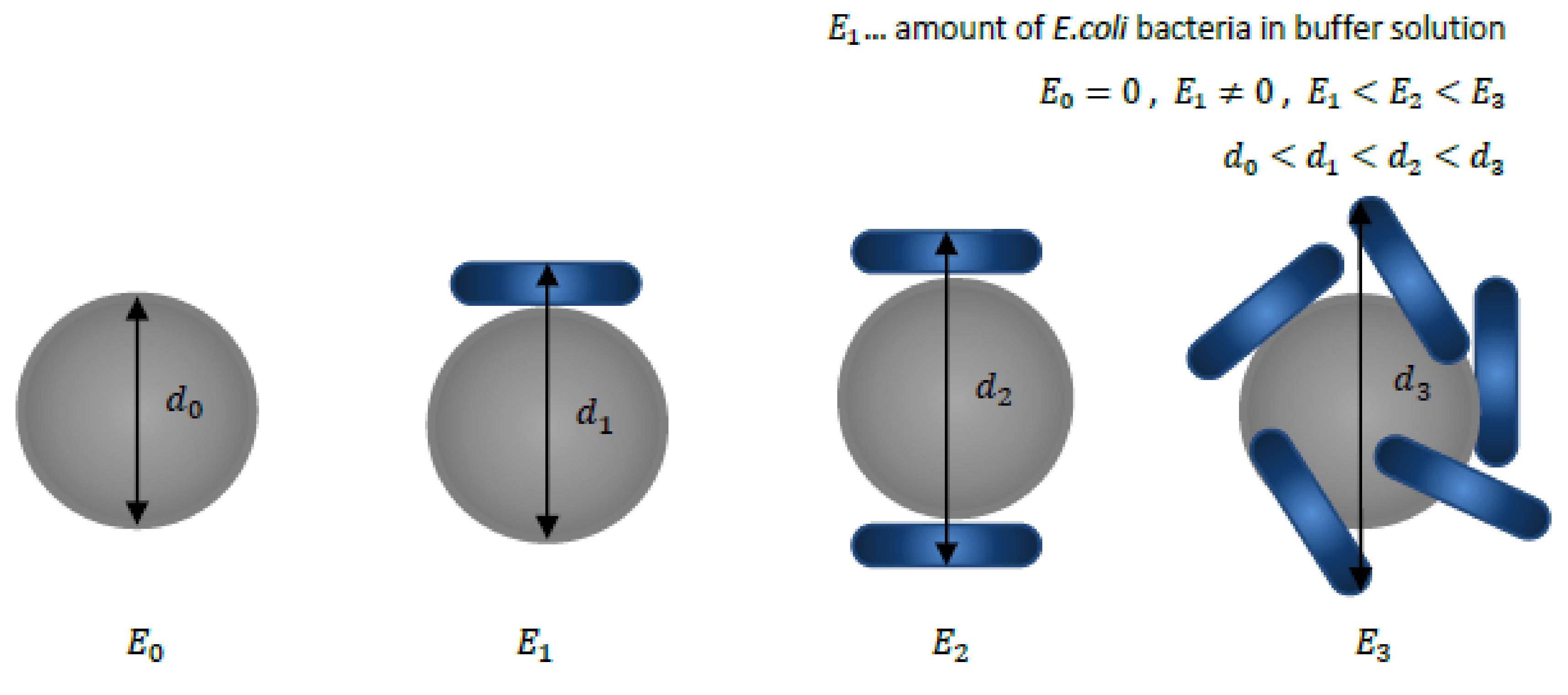
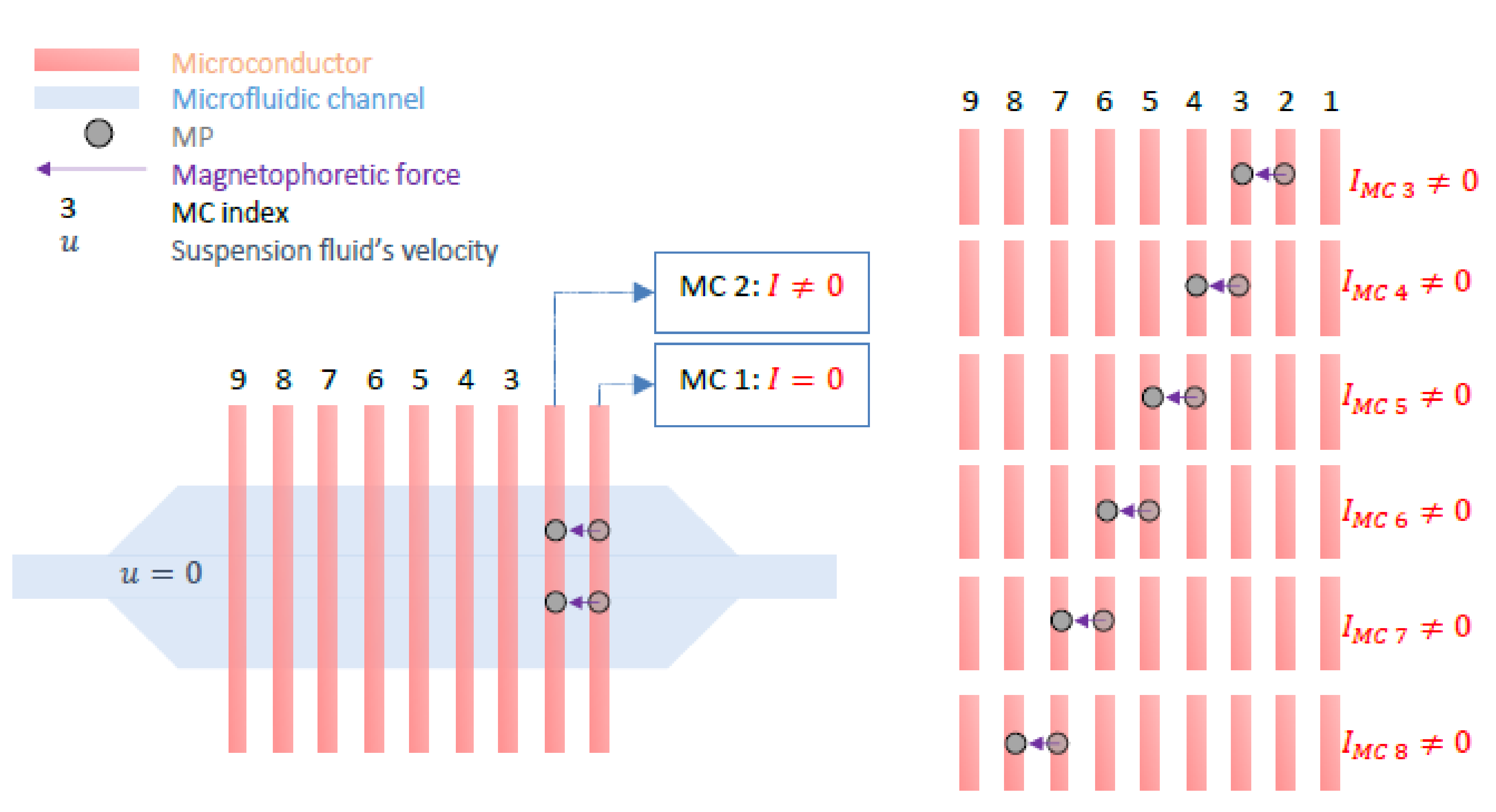
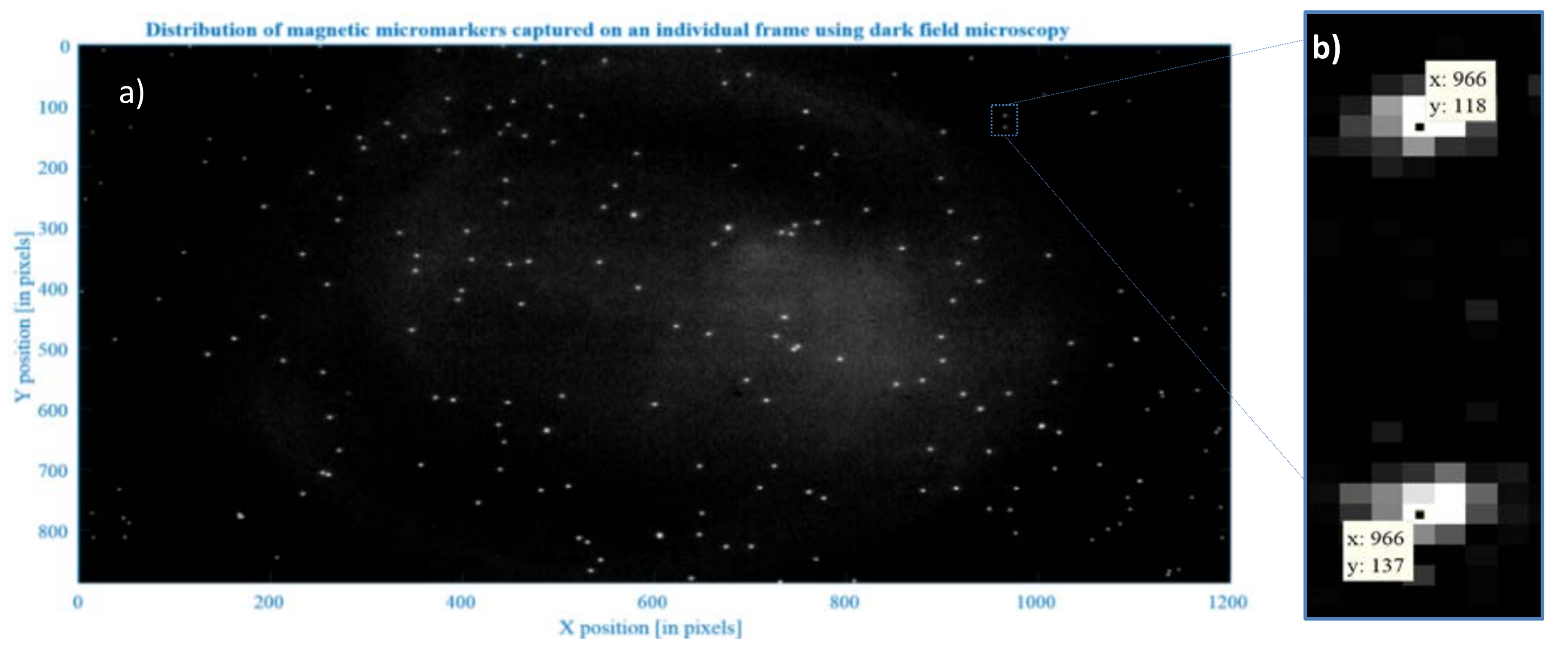



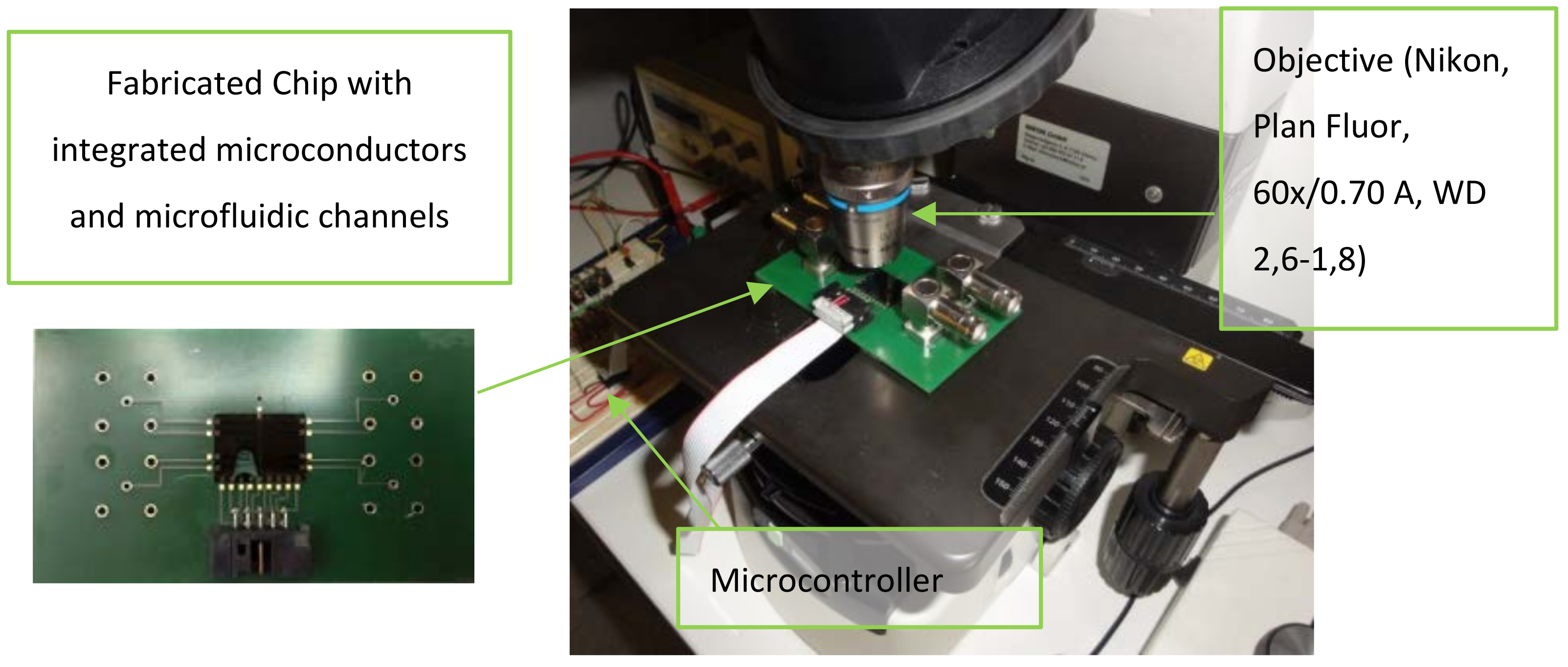
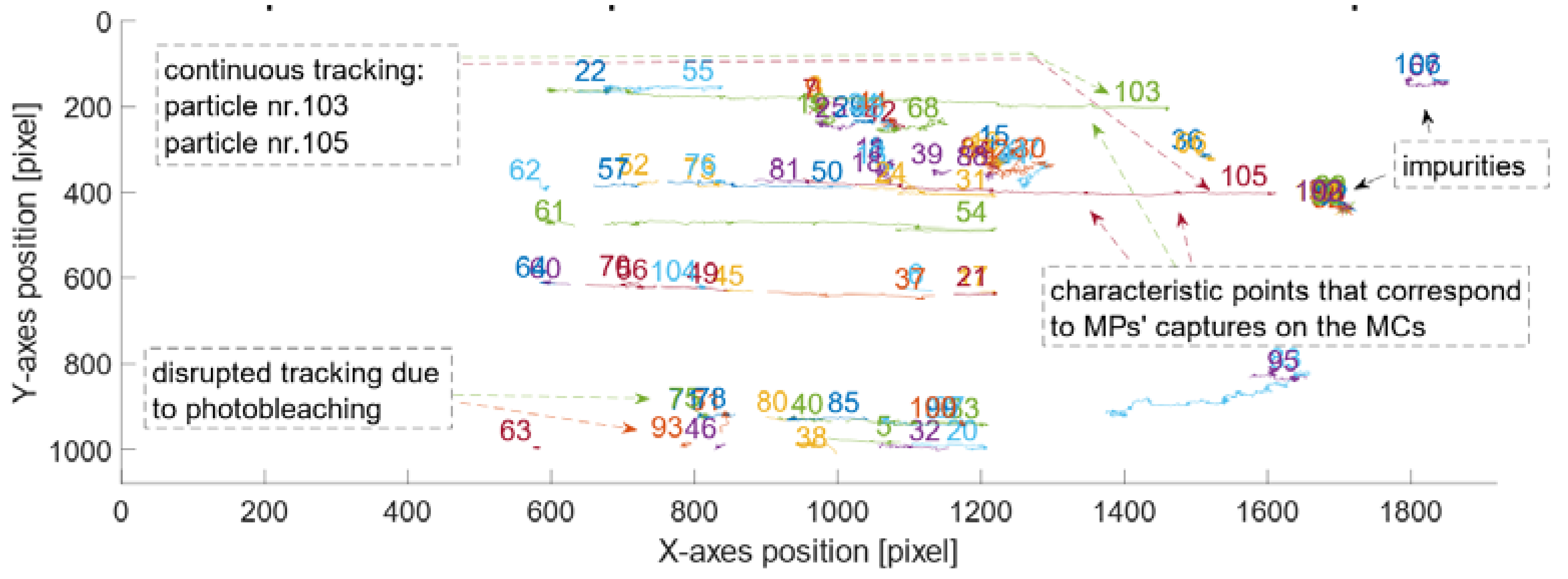
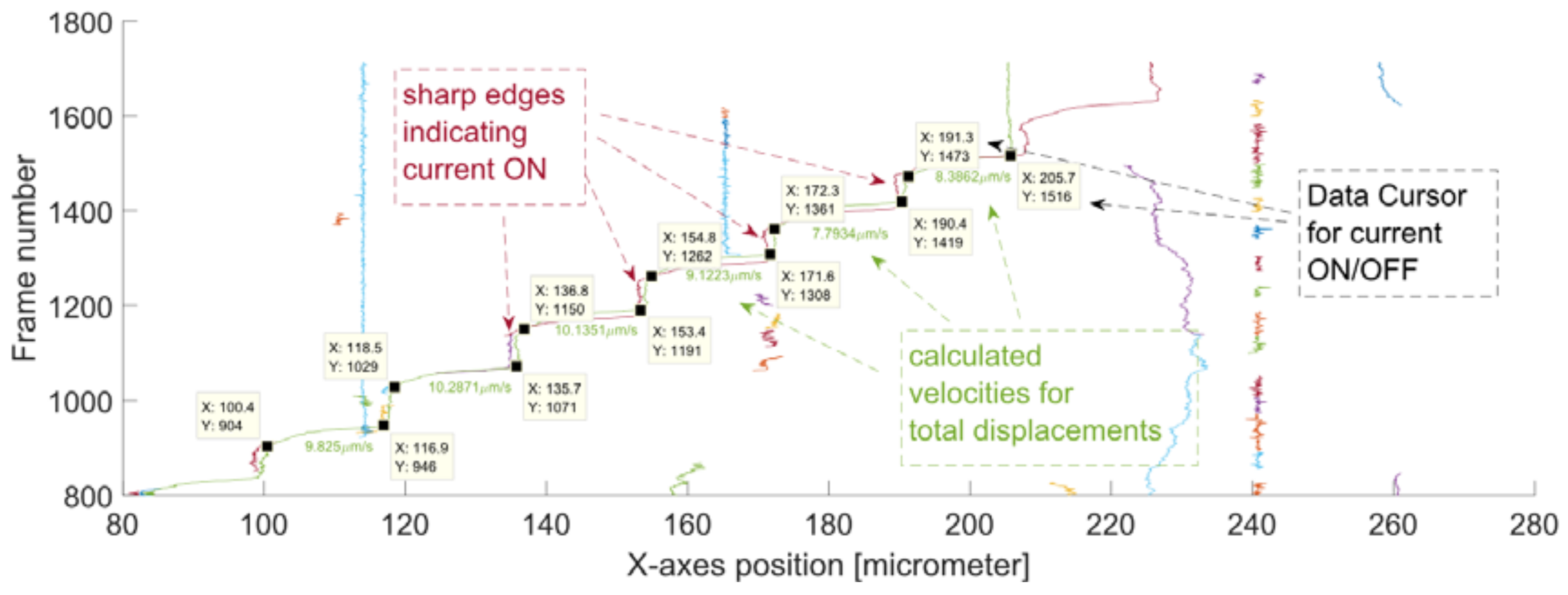
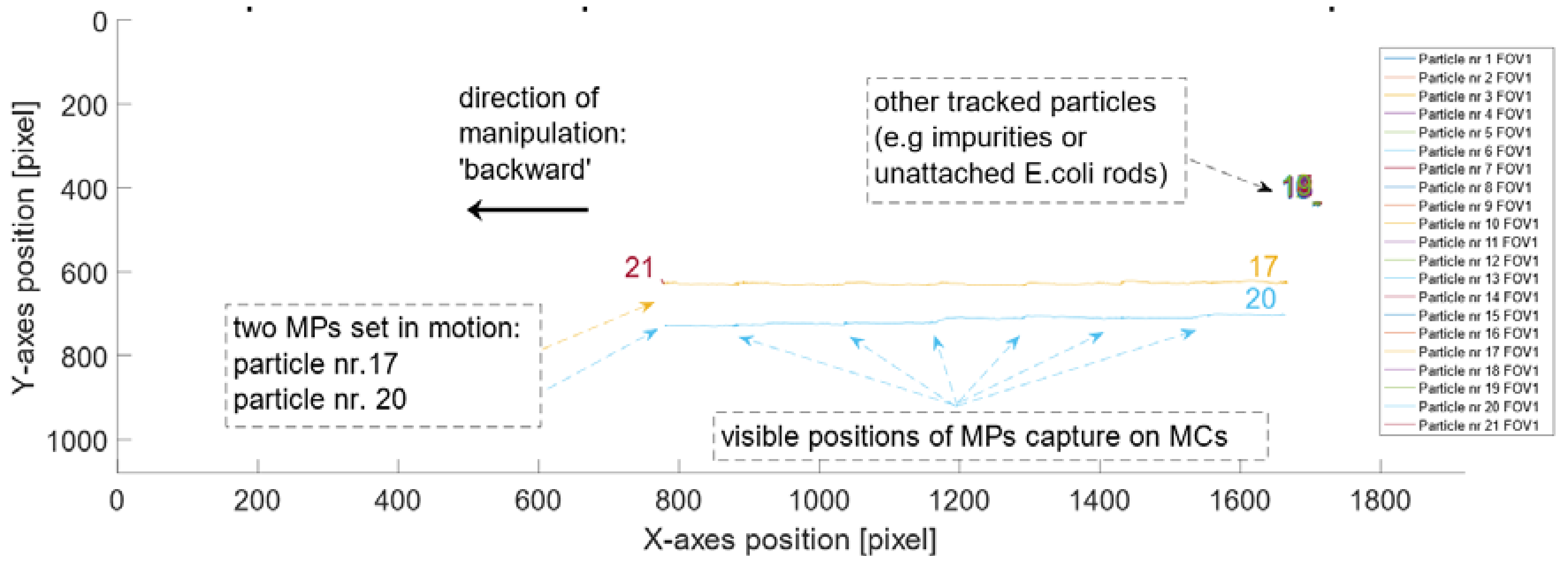
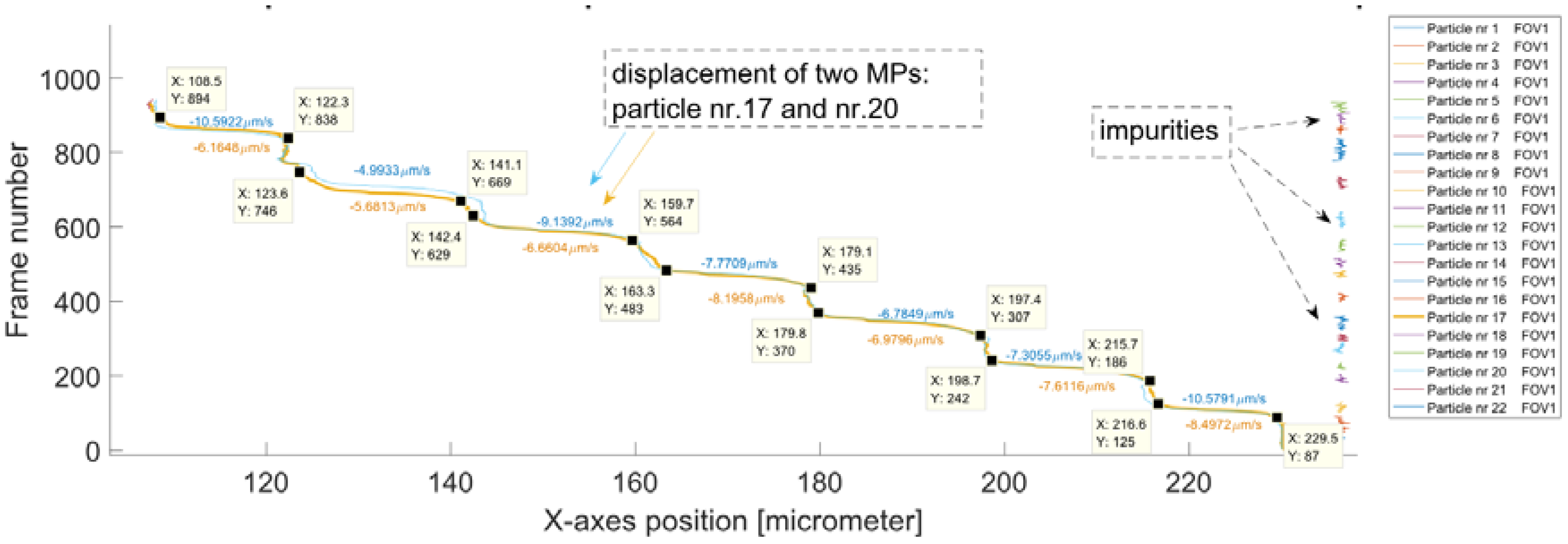
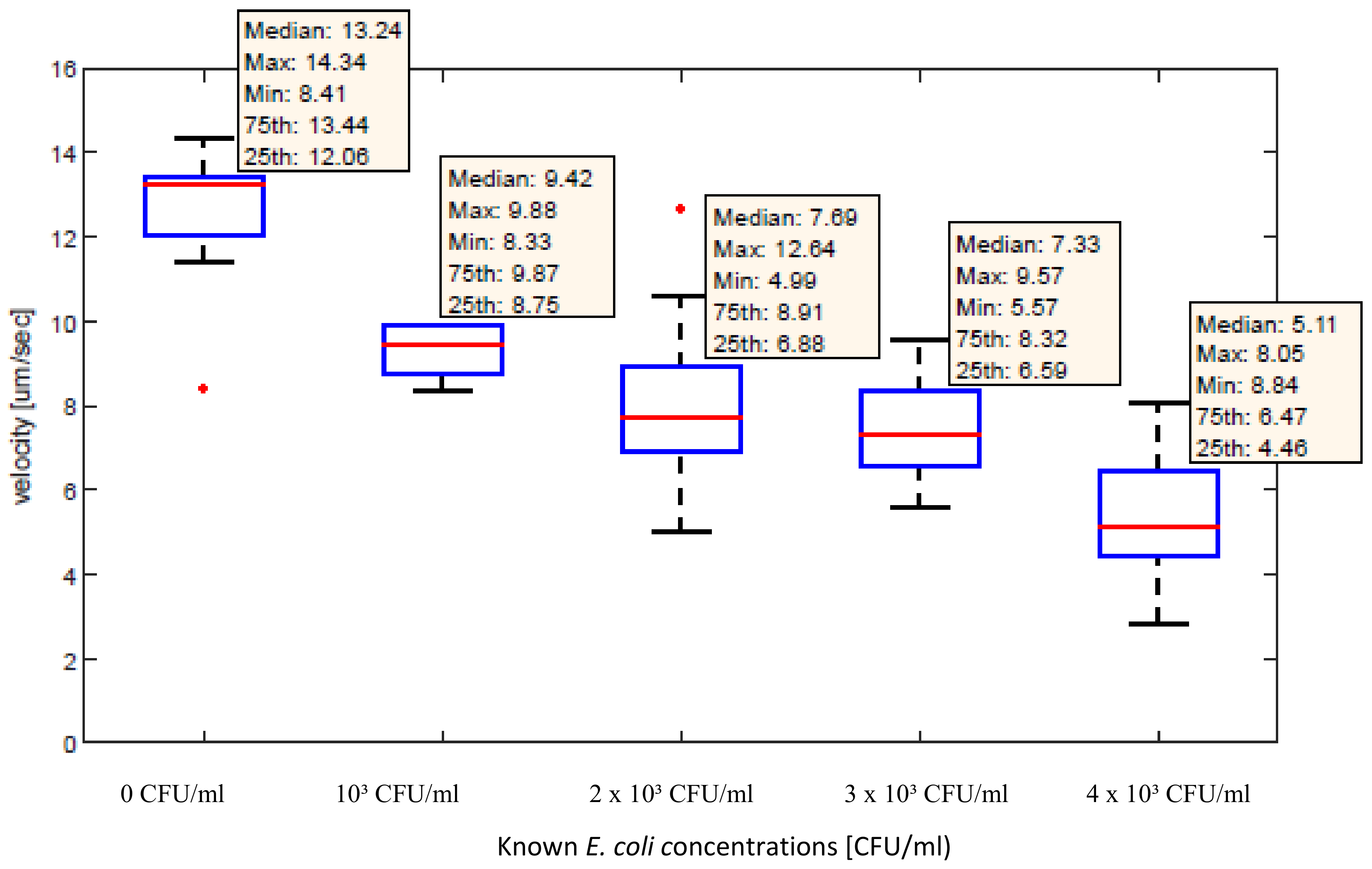
© 2018 by the authors. Licensee MDPI, Basel, Switzerland. This article is an open access article distributed under the terms and conditions of the Creative Commons Attribution (CC BY) license (http://creativecommons.org/licenses/by/4.0/).
Share and Cite
Malec, A.; Kokkinis, G.; Haiden, C.; Giouroudi, I. Biosensing System for Concentration Quantification of Magnetically Labeled E. coli in Water Samples. Sensors 2018, 18, 2250. https://doi.org/10.3390/s18072250
Malec A, Kokkinis G, Haiden C, Giouroudi I. Biosensing System for Concentration Quantification of Magnetically Labeled E. coli in Water Samples. Sensors. 2018; 18(7):2250. https://doi.org/10.3390/s18072250
Chicago/Turabian StyleMalec, Anna, Georgios Kokkinis, Christoph Haiden, and Ioanna Giouroudi. 2018. "Biosensing System for Concentration Quantification of Magnetically Labeled E. coli in Water Samples" Sensors 18, no. 7: 2250. https://doi.org/10.3390/s18072250
APA StyleMalec, A., Kokkinis, G., Haiden, C., & Giouroudi, I. (2018). Biosensing System for Concentration Quantification of Magnetically Labeled E. coli in Water Samples. Sensors, 18(7), 2250. https://doi.org/10.3390/s18072250




